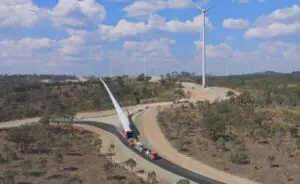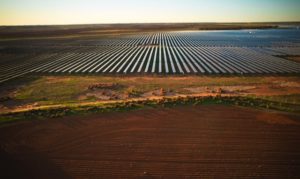On Tuesday in our Insights series, we saw how PV provided nearly 10% of midday power consumption across the NEM on September 29, and looked at regional solar coincident performance. Today we’re going to see the size and shape of the PV industry.
3GW PV Size and Shape
 The graph above shows the peaks and troughs that the solar industry experienced over the 2010-2012 period. The national (black) and state (coloured) lines indicate how the monthly installation figures in response to multiplier reductions and state feed-in tariff reductions. The precipitous plunge that resulted from the end of the FiT in NSW was followed by a very quiet second half of 2012, before installations started growing again of their own accord: smooth organic growth punctuated by peaks from multiplier reductions. Western Australia followed similar form but without the same recovery. Feed-in tariff closures proved equally as important as multiplier reductions in driving installation booms, as clearly shown in peak installation levels in Victoria and South Australia. Looking across the country, its clear why this period was known as a “solar coaster”.
The graph above shows the peaks and troughs that the solar industry experienced over the 2010-2012 period. The national (black) and state (coloured) lines indicate how the monthly installation figures in response to multiplier reductions and state feed-in tariff reductions. The precipitous plunge that resulted from the end of the FiT in NSW was followed by a very quiet second half of 2012, before installations started growing again of their own accord: smooth organic growth punctuated by peaks from multiplier reductions. Western Australia followed similar form but without the same recovery. Feed-in tariff closures proved equally as important as multiplier reductions in driving installation booms, as clearly shown in peak installation levels in Victoria and South Australia. Looking across the country, its clear why this period was known as a “solar coaster”.
Thankfully things have stabilised considerably in the past year. As system registration lags behind installation, it can take some months to obtain a clear picture of recent installation trends. SunWiz has created a calculator that projects recent installation volume from current registration activity. The graph below shows the expected monthly installation volume for the most recent year, compared to finalised data for the year before. Clearly 2013 is more stable; absent are the signature peaks of multiplier reductions. Queensland’s installation surge resulting from the completion of its 44c feed-in tariff is the main anomaly in otherwise steady installation levels, though South Australia is having a final surge as its feed-in tariff closes. Absent these factors, 50-60MW/month seems to be a consistent volume of installations.
The average system is growing in size too, to the point where the average system is now 4kW in capacity. The graph below shows average system size by month for each state (colour; smoothed) and nationally (black). When feed-in tariffs were removed in WA and NSW, the average system size fell markedly. However, since that point the average in these states as grown in parallel with the national average. NSW now sits in line with the national average (though this is because NSW is the most successful market for commercial PV, which it was forced to focus upon earlier than in other states due to the lack of feed-in tariff for residential systems), and WA is far behind. Since Queensland’s feed-in tariff installations were completed, average system size has declined markedly as there is no longer a 44c/kWh incentive to export power. Meanwhile average system sizes are currently high in Tasmania and South Australia, both of whom presently enjoy feed-in tariffs, though SA is also starting to fall back.
 A major reason that customers have been buying larger systems is their steadily-improving economy. The graph below shows the evolution of the net price (after STC discount) and calculated gross price (before STC discount) in terms of $/W for a range of system sizes of PV retailers that list prices through Solar Choice. More recent months are shown in darker blue, with the most recent month shown in pink. It can be seen that the gross price has near-continually declined over time, and that there is an appreciable economy of scale for larger systems. Net system prices have varied more as the solar multiplier was eliminated and as the STC price recovered. The average net price of a 5kW system has thus fallen by one-third from $12500/W in mid 2012 to $8000 today.
A major reason that customers have been buying larger systems is their steadily-improving economy. The graph below shows the evolution of the net price (after STC discount) and calculated gross price (before STC discount) in terms of $/W for a range of system sizes of PV retailers that list prices through Solar Choice. More recent months are shown in darker blue, with the most recent month shown in pink. It can be seen that the gross price has near-continually declined over time, and that there is an appreciable economy of scale for larger systems. Net system prices have varied more as the solar multiplier was eliminated and as the STC price recovered. The average net price of a 5kW system has thus fallen by one-third from $12500/W in mid 2012 to $8000 today.
Over this time the nature of solar installations has also shifted considerably. The national distribution of system sizes by quarter* reveals the earlier popularity of 1.5kW systems is now more focussed upon 5kW systems. At one point, half of all systems installed were 1.5kW in size. Most recently 25% have been 5kW in size. However, the shift towards larger residential systems seems to have plateaued. The proportion of 3kW, 4kW, and 5kW systems has been steady for almost a year; what we’re seeing now is the emergence of a market for commercial solar. 3% of systems installed recently are in the 10-30kW range, but 10% of volume (by kW) falls into this range, plus another 7% in the 30+kW range. Considering that in 2012 only 5% of capacity exceeded 10kW in size (and a lot of that was driven by solar schools and feed-in tariffs), we’re finally seeing a remarkable shift towards commercial PV in Australia. (*To see a graph of the distribution of system sizes and how it has evolved, subscribe to SunWiz’s special mailout here.)
Where has it ended up? The map below shows the total installed capacity by postcode (size of dot) and the proportion of total dwellings that have solar power. The greatest volume of solar power lies along the Queensland coast. There is clearly highest penetration in South Australia and South-east Queensland, though the area surrounding Perth also has a high solar density. Installations are naturally concentrated in capital cities, though there is greater geographic spread of solar in Victoria and New South Wales.Subscribers to Insights receive an overview of solar hot spots.
This information regularly appears in the Insights subscription. Still to come in this mini-series, we will look at large-scale systems, market share, and SunWiz-exclusive content.
Pricing insights are drawn from information and data provided by Solar Choice to SunWiz. Solar Choice Commercial impartially manages a large diversity of tenders for solar farms and commercial PV, and has energised some of Australia’s largest roll outs. Solar Choice Residential has assisted over 50,000 households to make a well informed selection of installer. Solar Choice has unique software to deliver objective, informative and immediate Quote Comparisons to the market, and follows through to broker and deliver installation contracts and deposit payments to its network of reputable installers.













